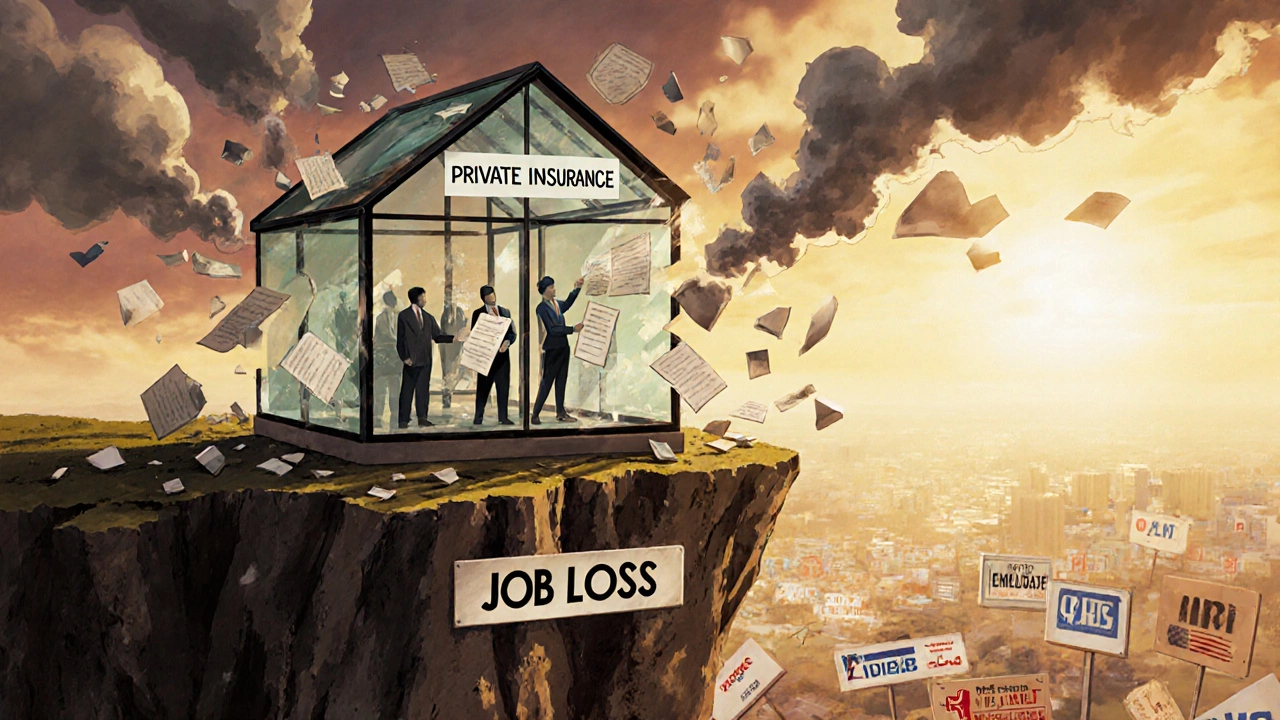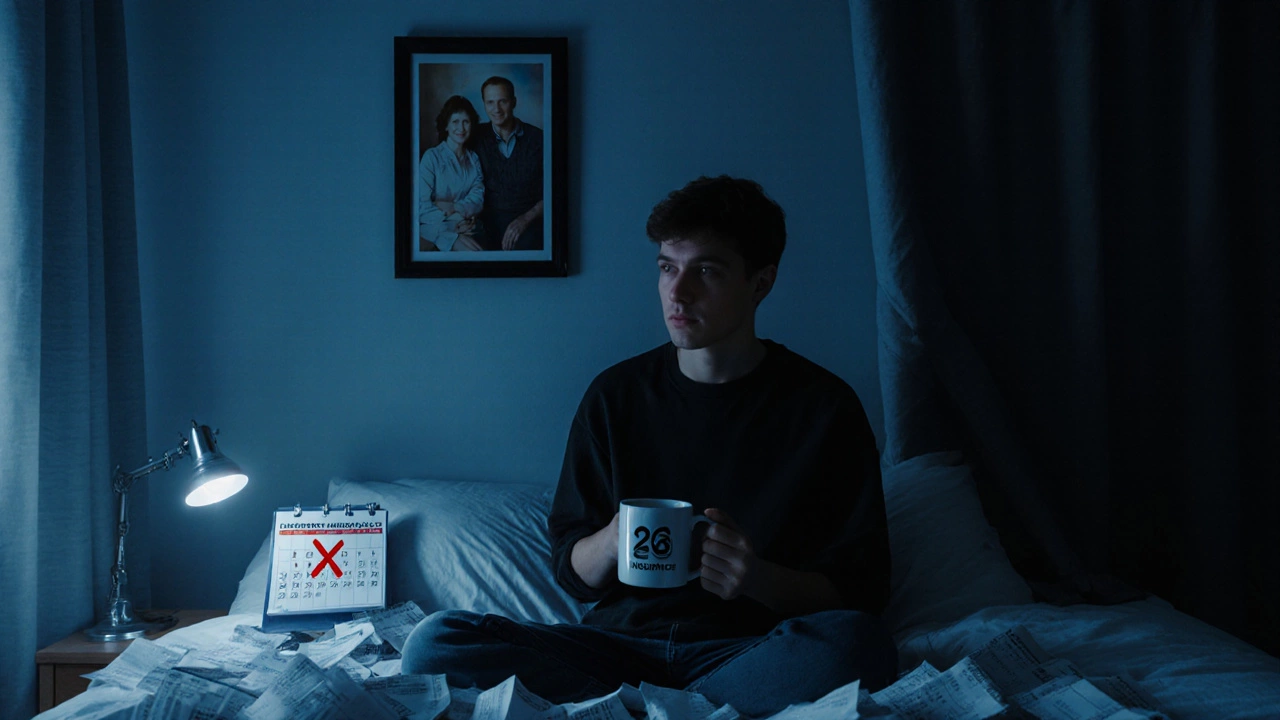Health Insurance Premium Calculator
Estimate your monthly health insurance costs based on U.S. Marketplace data. This tool uses 2024 ACA premium benchmarks to show potential costs and subsidies.
Estimated Monthly Cost
$0More than 180 million Americans have private health insurance. That’s not a guess-it’s the latest official count from the U.S. Census Bureau in 2024. But hearing that number doesn’t tell the whole story. The real question isn’t just whether most Americans have private insurance. It’s: who has it, how stable is it, and what happens when it falls apart?
How Private Insurance Works in the U.S.
In the United States, private health insurance isn’t something most people buy on their own. It’s tied to jobs. Around 158 million people get coverage through their employer or a family member’s job. That’s about 48% of the entire U.S. population. Employers pay part of the premium, and employees pay the rest through payroll deductions. This system started during World War II, when wage freezes pushed companies to offer health benefits as a way to attract workers. It stuck.
But not everyone works for a company that offers insurance. That’s where the individual market comes in. About 14 million Americans buy plans directly through the Health Insurance Marketplace, created by the Affordable Care Act in 2010. These plans vary wildly in cost and coverage. Some cost less than $200 a month after tax credits. Others run over $800, especially for older adults or people with pre-existing conditions who don’t qualify for subsidies.
Who Doesn’t Have Private Insurance?
About 26 million Americans are completely uninsured. That’s roughly 8% of the population. Most of them are working adults-often in low-wage jobs, gig work, or small businesses that don’t offer benefits. Many live in states that didn’t expand Medicaid, which leaves a gap for people earning too much to qualify for public aid but too little to afford private plans.
Young adults under 26 often stay on their parents’ plans, but once they turn 26, many drop out. One in five uninsured Americans are between 19 and 34. They think they’re healthy, so they skip insurance. Then they get sick. A broken leg, an emergency room visit for appendicitis, or a cancer diagnosis can wipe out savings in weeks.
Immigrants without legal status are also mostly excluded from private insurance markets. Even if they pay taxes, they can’t buy plans on the Marketplace. Some get care through community clinics, but those are stretched thin.
Public Insurance vs. Private Insurance
It’s easy to mix up private and public coverage. Medicare is public-it’s for people 65 and older or those with certain disabilities. Medicaid is public too-it’s for low-income families, pregnant women, and people with disabilities. Both are funded by the government.
But here’s the twist: over 70 million Americans are covered by Medicaid or Medicare. That means more than one in five U.S. residents rely on public insurance. If you add those numbers to the 180 million with private insurance, you get over 250 million people covered. That sounds great-until you realize the U.S. population is 335 million. So roughly 85 million people are either uninsured or underinsured.
Underinsured means they have insurance, but not enough. High deductibles, narrow provider networks, and surprise medical bills make many people avoid care even with coverage. A 2023 study in Health Affairs found that 43% of privately insured adults said they skipped a recommended test or treatment because of cost.

The Employer-Based System Is Fracturing
For decades, employer-based insurance was the backbone of U.S. healthcare. But that’s changing. More companies are cutting back. Some shift costs to employees with higher premiums and deductibles. Others drop coverage entirely and pay a penalty instead. In 2024, the number of workers at small businesses (<10 employees) with access to employer insurance dropped to 57%, down from 71% in 2010.
Freelancers, gig workers, and contract employees are growing fast. Uber drivers, DoorDash couriers, freelance designers-most don’t get health benefits. They’re forced into the individual market, where prices are higher and options are limited. A 35-year-old freelance graphic designer in Texas might pay $650 a month for a plan with a $7,000 deductible. That’s not insurance-it’s a financial gamble.
What Happens When Insurance Lapses?
People lose coverage all the time. They quit a job. They get laid off. They turn 26. Their income goes up and they lose Medicaid eligibility. Or their employer stops offering insurance. Each year, about 10 million Americans lose private coverage.
When that happens, they often wait until they’re really sick to seek care. A 2024 survey by the Kaiser Family Foundation found that 37% of uninsured adults waited more than six months to see a doctor because of cost. By then, minor issues become emergencies. Emergency rooms can’t turn people away, but they charge $1,200 to $3,000 for a basic visit. That bill doesn’t disappear. It turns into medical debt-the leading cause of bankruptcy in the U.S.

Is Private Insurance Actually Reliable?
Private insurance sounds secure, but it’s not. Plans change every year. Networks shrink. Doctors drop out. A plan that covers your specialist this year might exclude them next year. You might pay $300 a month for a plan that only covers 60% of your prescriptions. Or your insurer denies a claim for a procedure your doctor says you need.
Insurance companies are for-profit businesses. Their goal is to make money. That means they’ll use every rule in the book to avoid paying claims. Prior authorization? It’s a bottleneck. Denials? Common. Appeals? They take months. Many people give up.
And don’t forget the surprise bills. You go to an in-network hospital, but the anesthesiologist, radiologist, or lab tech is out-of-network. You get a bill for $4,000 you never saw coming. The No Surprises Act of 2022 helped, but it doesn’t cover everything.
How Other Countries Do It
Compare this to Canada, the UK, Germany, or Australia. In those countries, everyone has access to care through a public system. Private insurance exists, but it’s mostly for faster access or extra comforts-like a private room or elective procedures. It doesn’t replace the public safety net.
In the U.S., private insurance is the safety net. And it’s fraying. People don’t have healthcare-they have insurance policies. And policies can be canceled, changed, or denied.
What’s the Real Answer?
Yes, most Americans have private health insurance-about 54% of the population. But that number is misleading. When you add in public coverage (Medicare and Medicaid), 85% of Americans have some form of coverage. That sounds good. But 15% don’t. And even those with private insurance often can’t afford to use it.
The system isn’t broken because people lack insurance. It’s broken because insurance doesn’t guarantee care. It guarantees paperwork, delays, and debt.
If you’re one of the 180 million with private insurance, you’re lucky. But you’re also one missed paycheck, one job loss, or one medical bill away from disaster. That’s not a system. It’s a gamble.
Do most Americans have private health insurance?
Yes, about 180 million Americans-roughly 54% of the population-have private health insurance. Most get it through their job. But that doesn’t mean they’re fully protected. Many face high deductibles, limited networks, and surprise bills.
What percentage of Americans are uninsured?
As of 2024, about 8% of Americans-26 million people-are uninsured. Most are working adults in low-wage jobs, gig workers, or people living in states that didn’t expand Medicaid. Young adults under 35 make up a large share of this group.
Is employer-sponsored insurance reliable?
It’s unstable. More small businesses are dropping coverage. Premiums and deductibles keep rising. Even if you have it, your plan can change every year-your doctor might drop out, your prescriptions could be excluded, or your insurer might deny a claim. Losing your job means losing your insurance too.
How does Medicaid fit into this?
Medicaid covers over 80 million low-income Americans. It’s public insurance, not private. Many people who earn too much for Medicaid but too little for affordable private plans fall into a gap-especially in states that didn’t expand the program. That’s why some people remain uninsured even when they’re working full-time.
Why do people with insurance still avoid medical care?
High out-of-pocket costs. Even with insurance, many Americans face deductibles over $5,000, copays for specialist visits, and surprise bills from out-of-network providers. A 2023 study found that 43% of privately insured adults skipped needed care because of cost.
Can you buy private insurance if you’re unemployed?
Yes, through the Health Insurance Marketplace. But without employer help, premiums can be expensive. Tax credits can lower the cost if your income is below 400% of the federal poverty level. For example, a 30-year-old earning $35,000 a year might pay under $100/month after credits. But someone earning $55,000 might pay $700+ without help.





